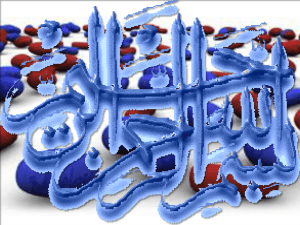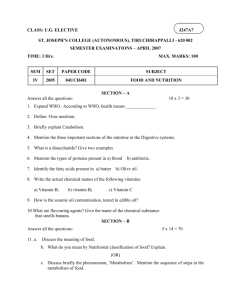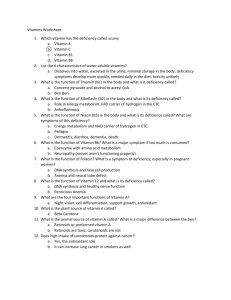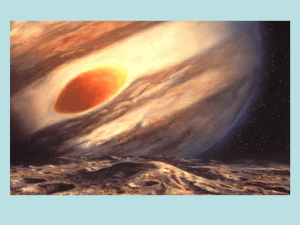Nutrition & Metabolism
advertisement
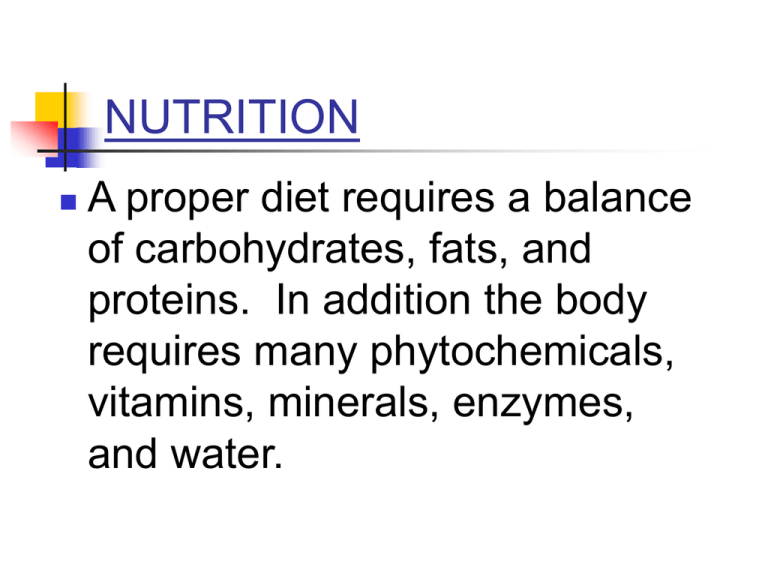
NUTRITION A proper diet requires a balance of carbohydrates, fats, and proteins. In addition the body requires many phytochemicals, vitamins, minerals, enzymes, and water. Food Intake Food energy measured in Calories Carbohydrates obtained primarily through plants Monosaccharides used for cellular fuel Minimum carbohydrates = 100 g/day Lipids < 30% of calories Mostly triglycerides Saturated fats usually from animals Cholesterol only from animals Neutral fats provide insulation and energy reserves Phospholipids for membranes and myelin Cholesterol for membranes, vitamin D, steroid hormones, and bile salts Proteins = 0.8 g/kg of body wt 8 Essential amino acids Plants usually lack 1 or more essential amino acids / Animal protein usually contains all Amino acids used to build structural proteins and enzymes VITAMINS: "vita" = Latin word for life. Vitamins are organic substances that act as coenzymes, chemicals that assist the enzymes in the bodies reactions. They do not provide energy or calories. Vitamins may be either Fat Soluble or Water Soluble. Fat soluble vitamins are stored in the body's fatty tissues. Fat soluble vitamins include the vitamins A D E K. Vitamin A Found in fish, liver, eggs, butter, yellow & green vegetables, fruits Needed for healthy skin, eyes, bones, teeth. Deficiency causes night blindness, skin disorders, kidney stones Vitamin D Found in liver, fish, eggs, milk, sunlight Needed for growth, healthy bones, metabolism of calcium & phosphorus Deficiency causes rickets, poor teeth and bones. Vitamin E Found in whole grains, leafy vegetables, milk, butter, vegetable oils Needed for healthy cell membranes, red blood cells Deficiency causes red cell rupture, muscle disorders Vitamin K Found in leafy vegetables, soybeans, made by intestinal bacteria Needed for normal blood clotting Deficiency causes slow clotting, hemorrhaging. Water soluble vitamins can be dissolved in water but cannot be stored in the tissues. They must be obtained each day from food. Water soluble vitamins include B1 (Thiamine) B2 (Riboflavin) Niacin B6 (Pyridoxine) Pantothenic Acid Biotin B12 Folic Acid C (Ascorbic acid) Vitamin B1 (Thiamine) Found in organ meats, whole grains, vegetables Needed for proper functioning of heart, nervous system, digestion Deficiency causes beriberi, cardiovascular disorders. Vitamin B2 (Riboflavin) Found in liver, poultry, milk, eggs, cheese, fish, green vegetables, whole grain Needed for metabolism of protein, carbohydrates, and fats, healthy skin Used to make FAD for metabolism Deficiency causes dim vision, premature aging, sore mouth Vitamin B6 (Pyridoxine) Found in meats, liver, whole grains, vegetables Needed for sodium and phosphorus balance Deficiency causes anemia, nausea, loss of appetite, nervousness Vitamin B12 Found in Liver, meats, eggs, cheese, dairy products Needed for red cell production, healthy nervous system. Deficiency causes pernicious anemia. Vitamin C Found in citrus and other fruits, leafy vegetables, tomatoes, potatoes Needed for healthy blood vessels, resistance to infection, healing Deficiency causes scurvy, bruising, bleeding gums Niacin Found in red meats, organ meats, fish, green vegetables Needed for metabolism, digestion, nerves, skin Used to make NAD for metabolism Deficiency causes pellagra, sore mouth, diarrhea, depression Folic Acid Found in green vegetables, liver, whole grains, legumes Needed for manufacture of proteins and red blood cells, needed for cell division, helps prevent spina bifida Deficiency causes inflamed tongue, diarrhea, B12 deficiency. MINERALS: Inorganic substances that are used in the chemical reactions of the body. Major minerals needed include: Calcium, Iodine, Iron, Magnesium, Phosphorus, Potassium, and Sodium. Calcium Found in milk, cheese, vegetables Needed for strong bones and teeth, blood clotting Iodine Found in seafoods, iodized salt Needed for normal thyroid metabolism, prevents goiter Iron Found in liver, meat, eggs Needed for red cell production, prevents anemia Magnesium Found in milk, meat, whole grains, legumes Needed for proper nerve and muscle functioning Phosphorus Found in milk, whole grains, meats, nuts, legumes Needed for tooth and bone development, ATP, nucleic acids Potassium Found in whole grains, fruits, legumes, meat Needed for proper nerve and muscle function Sodium Found in seafood, table salt Needed for water balance, proper nerve and muscle function Free Radicals charged molecules that become oxidized by combining with oxygen or the removal of hydrogen, causing electron deficiency. seek to regain the electron by removing it from other molecules, thus oxidizing them. set up a chain reaction that may damage cell structures such as DNA, cell membranes, or needed enzymes. Free radicals may be produced by normal metabolic processes, the immune system in response to disease, exposure to chemicals, toxins, or radiation. Free radical generation may be increased by exercise and stress. Damage caused by free radical generation is a major cause of the degenerative effects of aging, may cause cancers, damage to arterial walls leading to heart disease and/or stroke, and lead to other degenerative diseases such as Alzheimer’s. Antioxidants have a protective effect by neutralizing free radicals. best known antioxidants are Vitamin C, Vitamin E, and beta carotene. many others and possibly many yet to be discovered. proper number, types, and balance of is an important part of nutrition. METABOLISM Sum of all the chemical reactions occurring within the body Types of Metabolic Reactions Anabolic reactions - energy requiring synthesis reactions Catabolic reactions - energy releasing reactions that generate ATP Enzymes - globular proteins that act as catalysts Increase reaction rates Holoenzyme - a two-part enzyme consisting of a protein part and an organic cofactor Apoenzyme - the protein portion Coenzyme - the organic cofactor; usually a vitamin Energy Production Oxidation reactions - loss of an electron by an atom or molecule Reduction reactions - involves the gain of electrons by a molecule Coupled redox reactions Cellular Respiration Oxidation of Glucose Glucose Metabolism Glycolysis Acetyl Coenzyme A Krebs Cycle Electron Transport Chain Glycolysis Glucose molecules are broken down into two molecules of pyruvic acid in the cytoplasm of the cell Net gain of 2 molecules of ATP No oxygen required Fate of pyruvic acid depends on the oxygen availability Glycolysis Glucose C6H12O6 Glucose-6-phosphate ATP Fructose-6-phosphate ADP ATP Fructose 1,6, diphosphate ADP Glyceraldehyde-3-Phosphate or Dihydroxyacetone Phosphate 2Pyruvate (pyruvic acid) + 2NAD + 4ATP 2C3H4O3 + 2NADH+ + 2ATP (net) Acetyl CoA Formation Pyruvic acid is decarboxylated by the removal of CO2 into a two carbon acetyl group Occurs in the mitochondria of the cell Krebs Cycle - TCA Cycle Formation of citric acid when oxaloacetic acid combines with acetyl CoA Organic molecules are broken down, carbon dioxide is released and hydrogen atoms are removed & transferred by coenzymes NAD & FAD Kreb’s Cycle Acetyl CoA + Oxalocetic Acid Citric Acid Isocitric Acid CO2 NADH2 alpha-Ketoglutaric Acid CO2 NADH2 Succinyl CoA ATP Succinnic Acid FADH2 Fumaric Acid Malic Acid NADH2 Electron Transport Involves electron carrier molecules that will release energy in a controlled way This energy is used to generate ATP Occurs inner mitochondrial membrane Chemiosmosis Glucose Anabolism Glycogenesis - conversion of glucose to glycogen; stimulated by insulin Glycogenolysis - hydrolysis of glycogen to form glucose; stimulated by glucagon Gluconeogenesis - synthesis of glucose from non-carbohydrates such as fats and amino acids Lipid Metabolism Lipid Catabolism - Lipolysis Hydrolysis of triglycerides into glycerol and fatty acids Glycerol converted to G 3-P and then into pyruvic acid, then into the Kreb’s cycle Beta -oxidation of fatty acids occurs forming two-carbon fragments which is then attached to coenzyme A, forming acetyl CoA Protein Metabolism Proteins are converted into substances than can enter the Kreb’s cycle by deamination - loss of (NH2) from amino group decarboxylation - loss of CO2 molecule dehydrogenation - loss of hydrogen atom Protein synthesis involves transcription and translation
